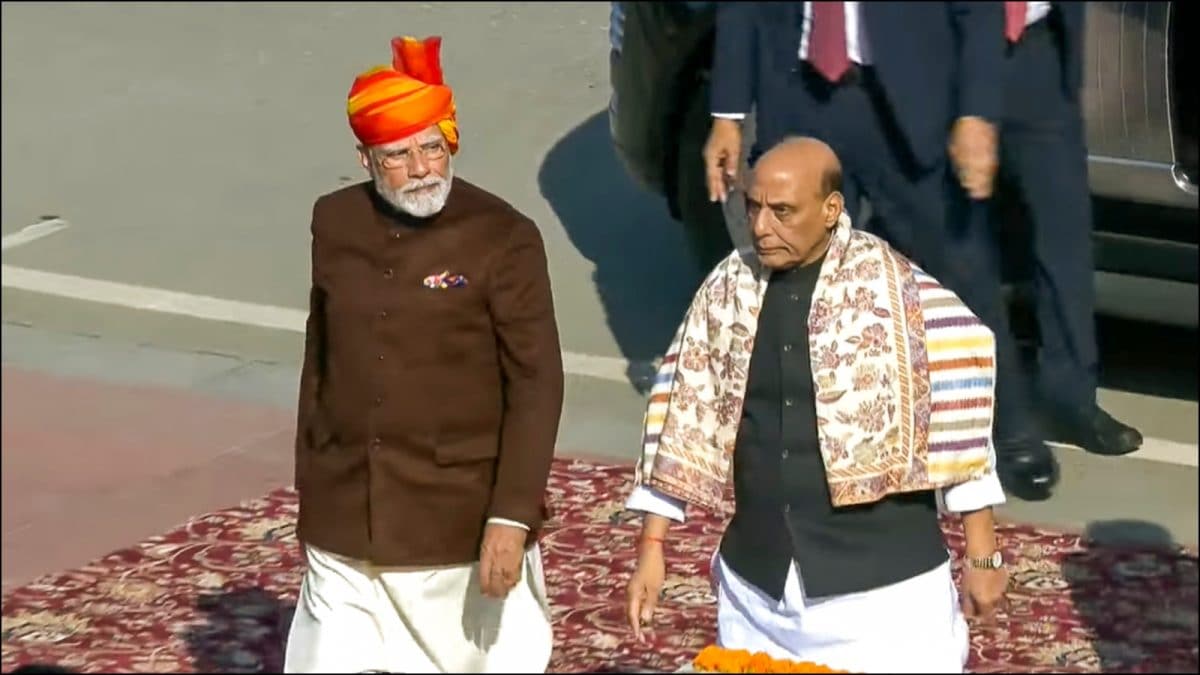 |
|
Prime Minister Narendra Modi's sartorial choices, particularly his turban selection for Republic Day celebrations, have consistently garnered significant attention. This year's Republic Day was no exception, with PM Modi choosing a vibrant red and yellow striped turban, complete with a long veil, for the occasion. Paired with a brown bandhgala jacket, a multi-coloured pocket square, white pyjama, and churidar pants, the outfit was a striking display of traditional Indian attire, further cementing his established 'Desi' look. The choice reflects not only a personal preference but also a calculated political strategy aimed at resonating with the Indian populace and projecting a strong image of national pride and cultural heritage. This carefully curated image is a recurring theme in PM Modi's public appearances, utilizing fashion as a tool of political communication.
The selection of a red and yellow turban is particularly significant, representing a blend of auspicious colors deeply ingrained in Indian culture. Red symbolizes courage, energy, and good fortune, while yellow signifies prosperity, wisdom, and spirituality. The combination conveys a sense of optimism and strength, aligning well with the celebratory nature of Republic Day and the overall message of national progress the government aims to portray. This year's Republic Day theme, "Swarnim Bharat: Virasat aur Vikas" (Golden India: Heritage and Progress), further underscores the relevance of Modi's attire, highlighting the seamless blend of India's rich cultural heritage with its aspirations for future development. The Prime Minister's attire serves as a visual embodiment of this theme, connecting the past with the future through a powerful and symbolic display.
The tradition of PM Modi choosing specific turbans for major national events has become a notable aspect of his public image. Previous years have witnessed a variety of colorful and patterned turbans, often featuring regional designs and highlighting India’s diverse textile traditions. These choices are meticulously planned, demonstrating an understanding of the visual impact of his attire and its ability to communicate messages beyond the purely aesthetic. Last year’s multi-coloured “bandhani” print turban and brown Nehru jacket, for example, conveyed a different yet equally impactful message, emphasizing another aspect of Indian culture. The careful selection and presentation of his attire contribute to his personal brand, consolidating his image as a strong national leader who is deeply connected to India's cultural roots. His consistent use of traditional Indian clothing on significant occasions serves to build a strong narrative of national pride and unity.
The attention given to PM Modi's clothing choices reflects a larger trend in contemporary politics, where personal style plays an increasingly significant role in shaping public perception. The way a leader presents himself visually contributes to the overall image and message they project. This is not merely a matter of personal preference; it's a calculated strategy, often employed by political consultants and image makers, to carefully cultivate a specific public persona. In Modi’s case, the consistent use of traditional Indian clothing, particularly the vibrant turbans, contributes significantly to his carefully crafted image as a strong, charismatic leader who is deeply connected to the Indian people and their cultural heritage. This strategic use of attire reinforces his political narrative, further cementing his standing as a prominent figure in Indian politics.
Beyond the political strategy, PM Modi's choice of attire also raises broader questions about the representation of culture in public life. His consistent use of traditional clothing offers a unique platform to showcase India's rich and diverse textile traditions to a national and international audience. Each turban, with its distinct color, pattern, and regional origin, tells a story about India’s cultural landscape. The public's reaction to these choices reflects the nation's own diverse perspectives and interpretations of cultural identity, making PM Modi’s wardrobe a subject of both admiration and debate. This interplay between attire, political strategy, and cultural representation showcases how fashion can be an influential force, transcending its purely aesthetic function and becoming a powerful tool in shaping political narratives and public discourse.
Source: PM Modi Continues 'Desi' Look Tradition On Republic Day, Dons Vibrant Yellow And Red Turban
